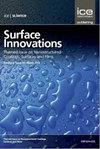Characterization of protein adsorption of amino acid conjugated self-assembled molecules modified SiO2 surfaces by QCM
IF 3.5
4区 材料科学
Q3 CHEMISTRY, PHYSICAL
引用次数: 1
Abstract
Protein adsorption has a crucial effect on biocompatibility during the interaction of biomaterial surfaces and the biological environment. It is significant to understand and control the interactions among biomaterials and proteins for several biomedical applications. Surface engineering plays a significant role to determine biocompatibility via tuning the effects directly on proteins. In this study, amino acid (histidine and leucine) conjugated self-assembled molecules (SAMs) were synthesized and used to modify silicon dioxide (SiO2) surfaces to investigate protein adsorption behavior. SiO2 surfaces were modified with (3-aminopropyl) triethoxysilane (APTES) conjugated histidine and leucine amino acids. Modified SiO2 surfaces were characterized by water contact angle measurements (WCA) and X-Ray Photoelectron Spectroscopy (XPS) analysis. Protein adsorption [Human Serum Albumin (HSA), fibrinogen, and Immunoglobulin G (IgG)] on SiO2 coated crystals was investigated in situ by using Quartz Crystal Microbalance (QCM) biosensor. According to the results, model proteins have shown different selectivity to the amino acid conjugated SiO2 coated crystals depending on the type of the amino acids and concentration. Consequently, this controlled chemistry on the surface of biomaterials has a great potential to manipulate protein adsorption and enhance the biocompatibility of biomaterials for various biomedical applications.氨基酸共轭自组装分子修饰SiO2表面对蛋白质吸附的QCM表征
在生物材料表面与生物环境的相互作用过程中,蛋白质吸附对生物相容性有着至关重要的影响。了解和控制生物材料和蛋白质之间的相互作用对于几种生物医学应用具有重要意义。表面工程通过直接调节对蛋白质的影响,在确定生物相容性方面发挥着重要作用。在本研究中,合成了氨基酸(组氨酸和亮氨酸)偶联的自组装分子(SAM),并将其用于修饰二氧化硅(SiO2)表面,以研究蛋白质的吸附行为。用(3-氨基丙基)三乙氧基硅烷(APTES)偶联的组氨酸和亮氨酸氨基酸修饰SiO2表面。通过水接触角测量(WCA)和X射线光电子能谱(XPS)分析对改性的SiO2表面进行了表征。使用石英晶体微天平(QCM)生物传感器原位研究了蛋白质在SiO2包被晶体上的吸附[人血清白蛋白(HSA)、纤维蛋白原和免疫球蛋白G(IgG)]。根据结果,根据氨基酸的类型和浓度,模型蛋白对氨基酸缀合的SiO2包被的晶体显示出不同的选择性。因此,生物材料表面的这种可控化学在操纵蛋白质吸附和增强生物材料的生物相容性方面具有巨大潜力,可用于各种生物医学应用。
本文章由计算机程序翻译,如有差异,请以英文原文为准。
求助全文
约1分钟内获得全文
求助全文
来源期刊

Surface Innovations
CHEMISTRY, PHYSICALMATERIALS SCIENCE, COAT-MATERIALS SCIENCE, COATINGS & FILMS
CiteScore
5.80
自引率
22.90%
发文量
66
期刊介绍:
The material innovations on surfaces, combined with understanding and manipulation of physics and chemistry of functional surfaces and coatings, have exploded in the past decade at an incredibly rapid pace.
Superhydrophobicity, superhydrophlicity, self-cleaning, self-healing, anti-fouling, anti-bacterial, etc., have become important fundamental topics of surface science research community driven by curiosity of physics, chemistry, and biology of interaction phenomenon at surfaces and their enormous potential in practical applications. Materials having controlled-functionality surfaces and coatings are important to the manufacturing of new products for environmental control, liquid manipulation, nanotechnological advances, biomedical engineering, pharmacy, biotechnology, and many others, and are part of the most promising technological innovations of the twenty-first century.
 求助内容:
求助内容: 应助结果提醒方式:
应助结果提醒方式:


